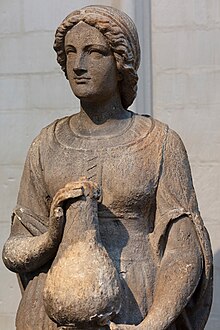| Saint Margaret of Louvain Marguerite la Fière | |
|---|---|
 Margaret of Louvain (chapel of St. Peter's Church, Leuven) Margaret of Louvain (chapel of St. Peter's Church, Leuven) | |
| Virgin Martyr | |
| Born | 1207 |
| Died | 1225 Louvain, Duchy of Brabant |
| Venerated in | Roman Catholic Church |
| Feast | 2 September |
| Patronage | domestic workers |
Margaret of Louvain (also known as Fiere Margriet or Margaretha de Trotse (Dutch); Marguerite la Fière (French); 1207–1225) was a servant murdered by thieves. She is venerated in the Roman Catholic Church; her shrine is in St. Peter's Church in Louvain.
Life
Margaret was a servant from Louvain, Duchy of Brabant (now Belgium). As a teenager, she worked at the inn belonging to her relatives, a certain Aubert and his wife, until they sold the establishment. The couple had planned to enter the religious life, with Margaret herself set on joining a Cistercian convent.
On their last night at the inn, Margaret was out when thieves broke in and murdered her employers. She returned as the assailants were leaving and saw what had happened; the thieves gave chase as she fled the scene. They eventually caught up with her along the banks of the Dyle River, where they killed her as well by slitting her throat.
Veneration
Margaret's killers had initially thrown her corpse into the Dyle, but it was recovered and buried on the riverbank where she was killed. Miracles were later attributed to her at her tomb, and her remains were subsequently translated and reinterred in a chapel in the yard of Saint Peter's Church in the centre of town.
The cause for Margaret's beatification was formally opened on 8 June 1896, granting her the title of Servant of God. In 1905, Pope Pius X confirmed her cultus.
Margaret is a patron saint of domestic workers.
Chapel of Margaret of Louvain

Relics
In St. Peter's Church, Leuven, the chasse with the relics of Margaret of Louvain are located in a chapel dedicated to her. In the thirteenth century, Margaret's remains were buried in a coffin in a chapel set up for her and built against the choir of St Peter's Church. During the French occupation in the eighteenth century, her remains were relocated to Germany. After said occupation, they were returned to Leuven in 1802.
In 1902 the shrine was made of gilded copper and adorned with semi-precious stones and co-financed by gifts from parishioners and young maids who honor Marguerite la Fière as their patron saint. The shrine has several panels, each describing a scene from Margaret's life. The first panel represents Margaret's devotion. On the second, the foster parents of the saint welcome the pilgrims to their inn. On the third panel the duke of Leuven kneels at Margaret's corpse. The funeral procession of Margaret can be seen on the fourth panel. The torture death of Margaret is then depicted. On the sixth panel a soldier sees the corpse of Margaret floating in the Dyle. Margaret is crowned by the angels on the penultimate and seventh panels. Finally, the veneration of Margaretha in Leuven is depicted.
Scenes by Pieter Verhaghen

Pieter Verhaegen, an artist from Leuven, painted five scenes from Margaretha's life in 1765. These can be seen in her chapel in St. Peter's Church.
References
- Baring-Gould, Sabine. The Lives of the Saints, Vol. 10, J. C. Nimmo, 1898, p. 17
- ^ Butler, Alban. The Lives of the Saints, Vol. IX: September. 1866
- Saint of the Day, September 2: Blessed Margaret of Louvain SaintPatrickDC.org. Retrieved 2012-03-08.
- Index ac status causarum beatificationis servorum dei et canonizationis beatorum (in Latin). Typis polyglottis vaticanis. January 1953. p. 141.
- ^ Baedeker, K., Belgium and Holland, 1897, p. 205
- 'Reliekschrijn van de Fiere Margriet', Erfgoedplus
- 1207 births
- 1225 deaths
- 13th-century women from the Holy Roman Empire
- Crime witnesses
- Roman Catholic child saints
- Female saints of medieval Belgium
- Belgian Roman Catholic saints
- People from Leuven
- People murdered in Belgium
- Servants
- Female murder victims
- Belgian domestic workers
- Violence against women in Belgium
- Virgin martyrs